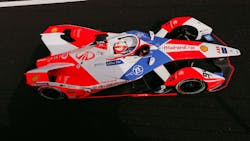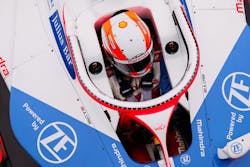This is the third of a three-part series. Part 1 can be found here, and Part 2 here.
Alexander Sims, a driver for Mahindra Racing, has been involved in Formula E since the series began in 2014. He started out testing the electric open-wheel racing cars before being selected as a driver in the Championship’s fifth season (2018). He became the first driver to earn three consecutive pole positions in Formula E.
Sims began his driving career at the tender age of 10 when he started competing in karts. He moved up to single-seater cars in 2008, racing in the Formula Renault 2.0 UK series and won the McLaren Autosport BRDC Young Driver of the Year Award.
Sims took the time out from his busy schedule to answer a few questions from Machine Design.
Machine Design: How would you compare driving an electric racecar to driving a racer with an internal combustion engine?
Alexander Sims: There isn’t much difference between driving an electric racer or one with a combustion engine. The main differences are how quiet electric cars are and their lack of different gears. The throttle response is also faster in an electric racecar, but you don’t notice it much on track. But you really feel it when you leave the pits.
MD: What are the major advantages/benefits of racing in an electric car?
AS: From a technical point of view, electric motors are superior to combustion engines in that you can control both the positive and negative torque in an instant. This isn’t as easy to do with a combustion engine and you can’t control it to the same extent you can in electric racers. The ability to adjust what the motor can do in electric cars through software is also really cool.
I can think of few disadvantages to electric motors. It likely depends on each driver’s perceptions. If you wanted to do longer races, however, then recharging and the battery’s thermal limitations would become more of an issue with ultra-high performance electric race cars. But in this championship, those are not issues for me.
MD: What advantages do gas-powered conventional race cars have over electric ones?
AS: The main advantage is the energy density of petrol. There is so much energy in a tank of petrol that it can power a car for a long time. Also, refueling times are much shorter, so it’s possible to completely refuel in the pits in about 30 seconds.
MD: Which is more “fun” to drive, electric or gas-powered racecars, and why?
AS: They both offer very different experiences, so it’s difficult to say categorically which is better. The rules of the championship and the racing format also have a huge impact on the experience. Ultimately, for pure enjoyment of going fast around a racetrack, it doesn’t matter much to me. It’s that feeling of getting the best performance from the car and pushing the tires to their limit that I enjoy.

